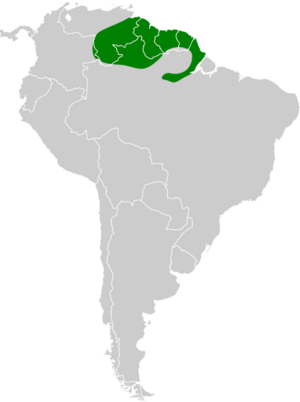Guianan streaked antwren facts for kids
Quick facts for kids Guianan streaked antwren |
|
|---|---|
 |
|
| male | |
 |
|
| female | |
| Conservation status | |
| Scientific classification | |
| Genus: |
Myrmotherula
|
| Species: |
surinamensis
|
 |
|
| Synonyms | |
|
Sitta surinamensis |
|
The Guianan streaked antwren (Myrmotherula surinamensis) is a small bird that lives in South America. It is part of the "typical antbirds" family. You can find this bird in countries like Brazil, Colombia, French Guiana, Guyana, Suriname, and Venezuela.
Contents
About the Guianan Streaked Antwren
How the Bird Got Its Name
The Guianan streaked antwren was first described in 1788. A German scientist named Johann Friedrich Gmelin gave it its first scientific name. He thought it was a type of nuthatch at first. Later, it was placed in the genus Myrmotherula, where it belongs today.
This bird used to be grouped with two other similar birds. These were the Pacific antwren and the Amazonian streaked antwren. But scientists noticed differences in their feathers and calls. So, they decided these three were separate species.
What Does the Guianan Streaked Antwren Look Like?
The Guianan streaked antwren is a small bird. It is about 9 to 10.5 centimeters (3.5 to 4.1 inches) long. It weighs around 7.5 to 9 grams (0.26 to 0.32 ounces). This bird has a very short tail.
Male and Female Antwrens
- Males have a black and white striped face. Their back and head are black with thin white stripes. They have a big white patch between their shoulders. Their tail is black with white edges. Their wings are black with white tips. Their chest and belly are white with black stripes.
- Females look a bit different. Their face is orange-buff. Their head and neck are cinnamon-rufous with black stripes. Their belly might have a buff color. Their chest can have fine stripes.
Where Do Guianan Streaked Antwrens Live?
The Guianan streaked antwren lives in eastern Colombia. It also lives across southern Venezuela and the Guianas. You can find it in northern Brazil too. It stays north and east of the Rio Negro and the Amazon River.
Preferred Homes of the Antwren
This bird likes to live in lowland evergreen forest. It especially likes forests that flood, like várzea and igapó forests. It also lives in bushy secondary forest (forest that has grown back).
It almost always lives near water. You can find it in thick bushes and vines near rivers, streams, and ponds. In French Guiana, it sometimes lives in mangrove swamps. It can live from sea level up to about 450 meters (1,476 feet) high.
Guianan Streaked Antwren Behavior
Movement and Daily Life
Scientists believe the Guianan streaked antwren stays in the same area all year. It does not migrate to other places.
What Guianan Streaked Antwrens Eat
The Guianan streaked antwren eats arthropods. These are mostly insects and probably spiders. It usually looks for food alone or with one other bird. Sometimes, it might join a group of different bird species looking for food.
It mostly searches for food between 1 and 15 meters (3.3 and 49 feet) above the ground or water. It actively looks for prey among leaves and vines. It also checks along branches. It picks up food by reaching, lunging, or flying briefly from its perch.
Reproduction and Life Cycle
We don't know much about when these birds breed. However, active nests have been seen from August to October. Young birds that still depend on their parents were seen in February.
One nest found in French Guiana was covered with moss. It was on a branch about 1 meter (3.3 feet) above water. This nest held two eggs.
Sounds and Calls
The Guianan streaked antwren has a special song. It is a short, sharp, even trill that sounds like "d-rrrrr". The "d-" part is a little lower in pitch. Its calls include a "complaining note" that often comes in pairs. It also makes a "short rattle" and a single, sudden "chit" sound.
Conservation Status of the Antwren
The IUCN (International Union for Conservation of Nature) checks on animal populations. They first said the Guianan streaked antwren was of "Least Concern" in 2004. This means it was not in danger. Then, in 2012, they changed it to "Vulnerable." But in 2023, it was changed back to "Least Concern."
This bird lives across a large area. We don't know exactly how many there are, but their numbers seem stable.
Threats to the Antwren's Habitat
The main threat to this bird is deforestation. This happens when forests are cut down for wood, cattle farms, or growing crops like soy. New roads also make it easier to clear land.
Even though deforestation is happening, large parts of the forest are still untouched. However, in some areas, especially in Brazil, a lot of trees are being cut down. The Guianan streaked antwren is considered uncommon to fairly common in most places it lives. It can live in areas where forests have grown back. This makes it less affected by changes than some other forest birds.
Images for kids



